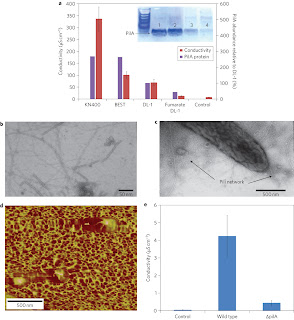Electronic nanostructures made from natural amino acids are attractive because of their relatively low cost, facile processing and absence of toxicity(1-3). However, most materials derived from natural amino acids are electronically insulating(1-6). Here, we report metallic-like conductivity in films of the bacterium Geobacter sulfurreducens(7) and also in pilin nanofilaments (known as microbial nanowires(8,9)) extracted from these bacteria. These materials have electronic conductivities of similar to 5 mS cm(-1), which are comparable to those of synthetic metallic nanostructures(2). They can also conduct over distances on the centimetre scale, which is thousands of times the size of a bacterium. Moreover, the conductivity of the biofilm can be tuned by regulating gene expression, and also by varying the gate voltage in a transistor configuration. The conductivity of the nanofilaments has a temperature dependence similar to that of a disordered metal, and the conductivity could be increased by processing.
Sunday, May 13, 2012
Electronic nanostructures made from natural amino acids are attractive because of their relatively low cost, facile processing and absence of toxicity(1-3). However, most materials derived from natural amino acids are electronically insulating(1-6). Here, we report metallic-like conductivity in films of the bacterium Geobacter sulfurreducens(7) and also in pilin nanofilaments (known as microbial nanowires(8,9)) extracted from these bacteria. These materials have electronic conductivities of similar to 5 mS cm(-1), which are comparable to those of synthetic metallic nanostructures(2). They can also conduct over distances on the centimetre scale, which is thousands of times the size of a bacterium. Moreover, the conductivity of the biofilm can be tuned by regulating gene expression, and also by varying the gate voltage in a transistor configuration. The conductivity of the nanofilaments has a temperature dependence similar to that of a disordered metal, and the conductivity could be increased by processing.
Subscribe to:
Post Comments (Atom)

No comments:
Post a Comment